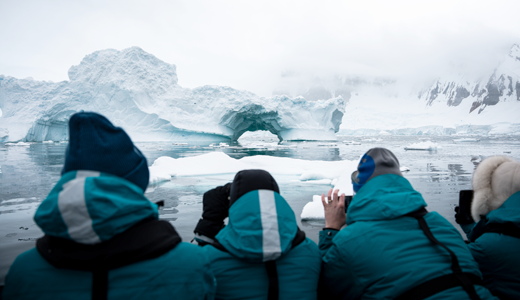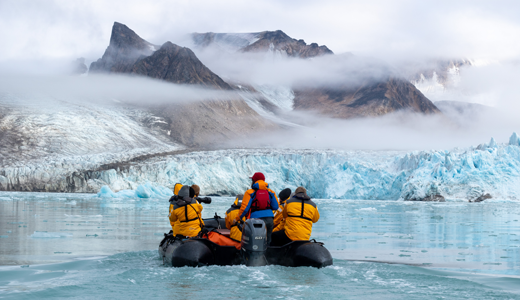Peninsula Antarctica Odyssey - Exploring the white continent
with Epic Polar - via Swan HellenicBiologist and full time traveler Maysa Santoro shares her experience of traveling to Antarctica onboard a Swan Hellenic vessel SH Diana with Epic Polar
Antarctica is unique and one of the most perfectly preserved regions on the planet. Is a cold, remote area in the Southern Hemisphere encompassed by the Antarctic Convergence, an uneven line of latitude where cold Antarctic waters meet the warmer waters of the world’s oceans. Antarctica is known for being the coldest, windiest, driest place in the world and believe it or not is a continent with no permanent human habitation, but scientific stations living on a rotating basis.

Although it is a remote place to visit, tourism is possible and regulated by IAATO (International Association Antarctica Tour Operators) a member organization founded in 1991 to advocate and promote the practice of safe and environmentally responsible private-sector travel to the Antarctic.
Ushuaia - Peninsula Antarctica - Ushuaia
Our expedition began and returned in Ushuaia, a city also known as "The City of the End of the World" in Argentina, our starting point to embark on an exciting 11-day journey aboard the SH Diana!
Drake Passage
The Drake Passage is the ocean between the tip of South America and the Antarctic Peninsula, so feared for its high waves and violent winds. The unpredictability of the weather makes this crossing even more exciting for those who sail: anything can happen, from waves measuring 1 meter to 10 meters high.
Fortunately our 2 day crossing was peaceful and the waves didn't exceed 3 meters. At the sea, it was possible to study on board in the most diverse lectures given by the Swan Hellenic biologists, and go out to the bow of the ship with binoculars to identify the seabirds that live in this part of the world, such as some species of petrels and albatrosses.

It was so exciting when on New Year's Eve at midnight we saw the first iceberg and the first humpback whales feeding very close to us! January 1st, 2014… we arrived in Antarctica! It was midnight, but light as day! The polar regions share a singularity: the sun does not set in the summer months, a phenomenon called midnight sun.

Humpback whales (scientific name: Megaptera novaeangliae) are migratory whales. In this part of the world, during the summer, they go to Antarctica to feed mainly on krill, small crustaceans at the base of the food chain, and during the winter, they move more than 3 thousand km towards the tropics to reach the regions of Brazil where they find warmer temperatures for reproduction. It is worth mentioning that the calves are born with a layer of fat that is still thin enough to withstand the frozen waters of the south, which justifies the long journey. They are fascinating animals and seeing them from the bedroom balcony when we woke up was another gift from the expedition!
I remember not being able to close my eyes, sit away from the windows or do anything other than look at this continent. Antarctica is the most beautiful place I have ever seen in my life!
I have never valued my eyes as much as I did here… how great it is to be able to see so much beauty!
Day 1: Mikkelsen Harbor & Cierva Cove
First official day on the Antarctic peninsula. We woke up in Mikkelsen Harbor and disembarked on a black sand beach of volcanic origin. We barely arrived and we were greeted by a playful and curious southern elephant seal cub that was more interested in smelling our zodiac than resting on top of a rock. It was a fun reception! Southern elephant seals (Mirounga leonina) live in sub-Antarctic and Antarctic waters that feature brutally cold conditions but are rich in the fish, squid, and other marine foods these seals enjoy.



We hiked for a few meters and soon found a colony of Gentoo penguins, grouped on top of one of the only snow-free rocks in this part of the mountain. By the way, Gentoo penguins (Pygoscelis papua) tend to choose rocks to build their nests and rest from long hours of diving in search of food in the Southern Ocean.
After our first landing, we returned to the Swan Hellenic ship SH Diana, had lunch, rested a little and soon it was time to explore again! Here in Antarctica we all know that there is no time to waste, every minute of good weather is valuable. So in the afternoon, we went on a zodiac safari in Cierva Cove. It was time to look for icebergs of different sizes and shapes, as well as any marine life possible, but little did we know that the mountains would be what caught our attention the most.

In fact, Antarctica is considered the highest continent in the world, with Mountain Vision being the highest mountain reaching 4892 m altitude (16050 ft) and the average mountain 2500 m (8200 ft).


As the sun doesn't set in polar summer, late at night we were still able to enjoy the sunny day from our room's balcony.
Day 2: Orne Harbor & Brown Station
A morning I will never forget. It all started at 1am when I accidentally opened my eyes while sleeping. I noticed the discreet light coming in from behind a powerful black out curtain, but it was enough to remind me that even though the room was dark, everything outside is always bright at this time of year. As the sun doesn't set in the summer in the polar regions, it gives us even more opportunities to observe the mountains, icebergs, whales and penguins that, while hunting, jump out of the water to breathe and catch impulse, which is beautiful Without wanting to miss a minute of this experience, I went straight to our balcony and took some pictures.

I only slept for a few hours, the alarm clock rang and the expedition boat stopped… we arrived at our first destination of the day, Orne Harbor! As usual, I ran to the balcony and had a special surprise: two humpback whales sleeping very close to us. We know when a humpback is resting because it remains at the surface without moving its caudal fin and breathing more spaced out and with less pressure. At the same time, we saw penguins swimming that jumped very close to them. On one side, wildlife in front of a glacier, and on the other, a steep mountain with a zigzag trail. This would be the first activity of the day, conquering the summit!

Well, neither for me nor for the other 6 tourists who were with us. After an important meeting on the first day where those interested in Kayak went through an interview to talk about their previous experiences with this activity, we were one of those selected to get in the water and paddle! And it was certainly one of the most memorable moments of the entire expedition!
I strongly suggest you to practice wherever you are to gain a level of prior experience if you want to kayak in polar regions one day. It's really worth it because in the kayak we change our perspective, being almost at the same level as the water where the penguins are swimming and jumping. We also passed very close by to the glacier and it was so beautiful to see and to hear the sound that the breaking ice makes in the water!



The second destination of the day was Brown Station, an Argentine research station almost entirely taken over by gentoo penguins and with a viewpoint of 84 m (276 ft) that gave us great views of the area!
Day 3: Port Lockroy, polar plunge & Lemaire Channel
For more than a century Port Lockroy has been home to explorers, whalers, scientists, and sailors, especially due its sheltered harbor.
Port Lockroy is the world's southernmost post office, Britain's first permanent Antarctic base and now home to penguins as well as the members of the UK Heritage Trust, an NGO responsible for preserve historic buildings and artifacts in Antarctica to help current and future generations discover, understand, value and protect this precious wilderness.
By the way, this year our landing here was not allowed for a good reason. The penguin colony was big, containing more than 1000 individuals! As it is a small area and we were unable to maintain the 5m distance recommended by IAATO, we remained on the ship and received a lecture by the volunteers of the UK Heritage Trust. It was so inspiring to hear from them their daily challenges and activities in one of the most remote places on the planet!

Shortly after lunch, we moved and arrived at Hidden Bay, an ideal place to do the famous polar plunge, a tradition in the polar regions. The water was close to zero degrees, the skin on my face hurt, but how good it is to touch our body in cold water like Antarctica! It is certainly a way for us to be part of that environment, stimulating not only our eyes with such beauty, but also the largest organ in our body, our skin.
To end the day on a high note, we travel along the Lemaire Channel, an impressive channel with mountains on both sides! We barely knew where to look, so to not miss anything we went straight to the front of the ship.

Day 4: Portal point & Charlotte Bay
Portal Point was our first destination of the day and as soon as we landed we saw a weddell seal resting next to our trail. The weddell seal (Leptonychotes weddellii) is a relatively large and abundant seal with a circumpolar distribution surrounding Antarctica and didn't seem to mind our presence at all! So as a photographer and wildlife lover, I couldn't go much further and chose to spend most of my time in Portal Point observing this incredible animal!


After this amazing landing, we head out to our next destination of the day and I must admit: Charlotte Bay has my heart. The landscape was beyond anything I've ever seen in my life! We found the most beautiful iceberg of the region, and had a plus to spot several crabeater seals (another species of seal) resting on the icebergs!


Although the popular name of the crabeater seals (Lobodon carcinophaga) suggests that this species of seal feeds on crabs, they actually feed mainly on krill, which has a natural red - ish color. Also, they have highly specialized lobed teeth that allow them to swim through swarms of krill and filter out the tiny crustaceans from seawater like a siege, an important adaptation for survival!

And the safari hasn't ended yet. We had the pleasure to see another species of penguin, the chinstrap (Pygoscelis antarcticus) for the first time! What I found the most impressive about them is their ability to micro-sleep. A study recently published in the journal Science revealed that chinstrap penguins take approximately 10 THOUSAND naps a day! This study found that each of these naps lasts an average of just 4 seconds when they are in the nest. Adding each of them together, they can accumulate around 11 hours of sleep daily! This is probably an adaptation for survival that allows them to maintain constant vigilance in their nests, protecting eggs and chicks against predators. Taking so many short naps wouldn't be good for us humans, but apparently for this species it's a positive thing :)
Day 5: Deception Island
What a mind blowing environment!! Deception Island is one of the two active volcanoes in Antarctica. It has a small channel where we entered the ship, sailed through its now flooded crater, and landed into Whalers Bay, a bay that was formerly a place for whale hunting but is now used for seismic monitoring and scientific research.


The scenery here was impressive, we walked on land and no longer through snow as the ground is hot due to volcanic activity. I must admit it was hard to see the remains from the Norwegian Whaling station and imagine all they had to do back then to have their source of food and energy, but at the same time I felt so lucky to be here now and witness how we don't need to whaling anymore for that matter. Now this place has became home for the new curious adventures like me and hopefully you in the future :))

Returning To Ushuaia
The way back was rougher with waves over 7m. We were still able to relax and enjoy the ship's options, with good food, good entertainment on board and a rich library to study. Where in the past explorers struggled to reach Antarctica, today it is possible with good expedition boats that not only make the trip possible, but comfortable and with a good education on board. After all, sometimes enjoying the journey is as important as arriving at the final destination.
What to take on an expedition to Antarctica?
The important thing is to dress in layers and make sure the last layer is waterproof. It is recommended to wear a second-skin t-shirt followed by fleece and second-skin pants followed by waterproof pants. Wearing accessories such as a hat, gloves and balaclava are essential.
Swan Hellenic provides a parka on board for us to keep (a two-layer coat with the outer layer being waterproof) and mucky boots during the expedition.
ANTARCTICA SEASON:
From November to March
Every time I am in a unique environment like this I feel a strong call to action. It is by knowing that we care and only mobilize for big changes when we actually feel like we belong. Visiting the polar regions is like opening a window onto a new environment never before seen anywhere else in the world!
BOOK HERE

Written by: Maysa Santoro (instagram @maysasantoro)
Biologist, photographer, expedition leader and content creator.





